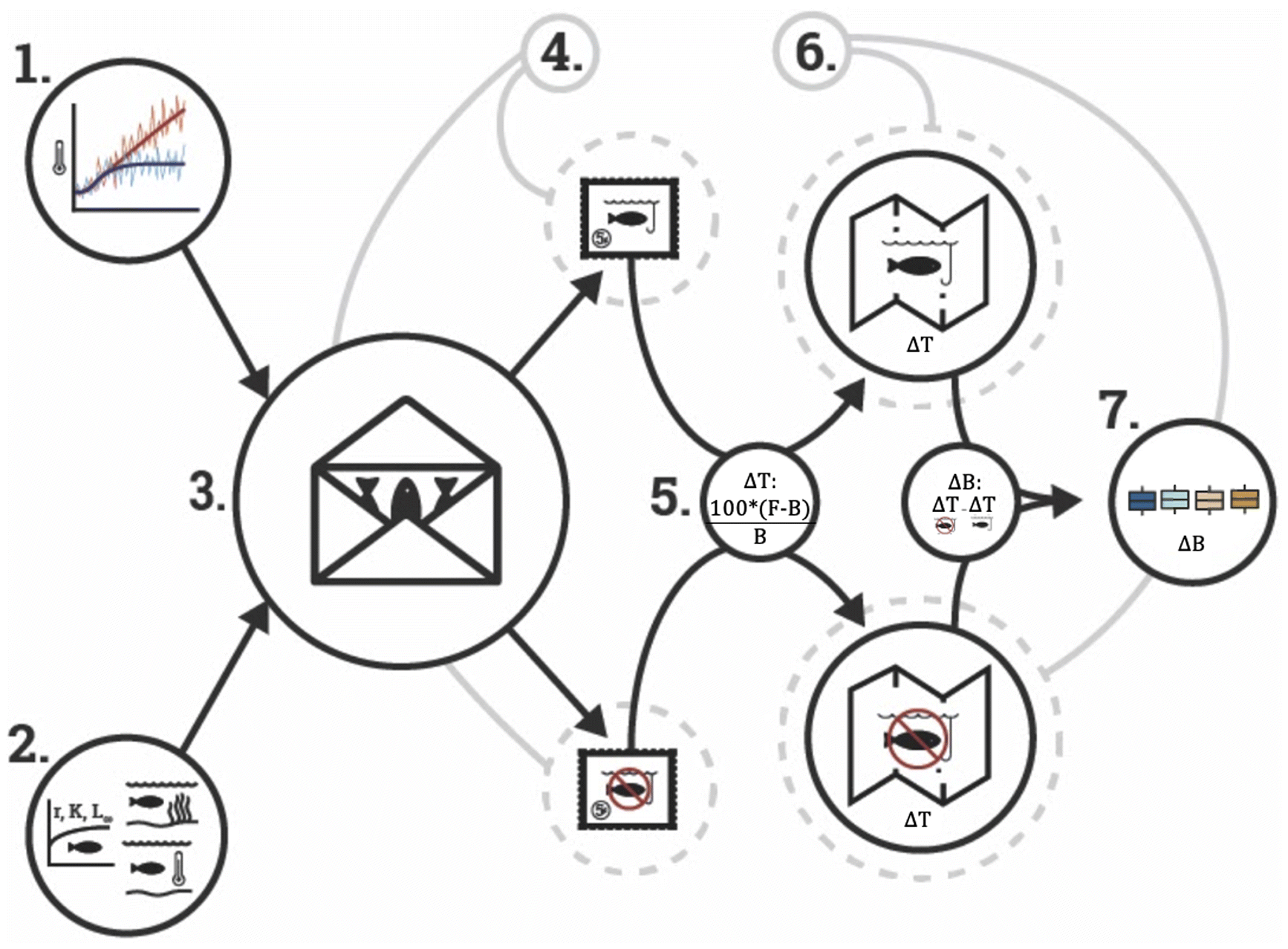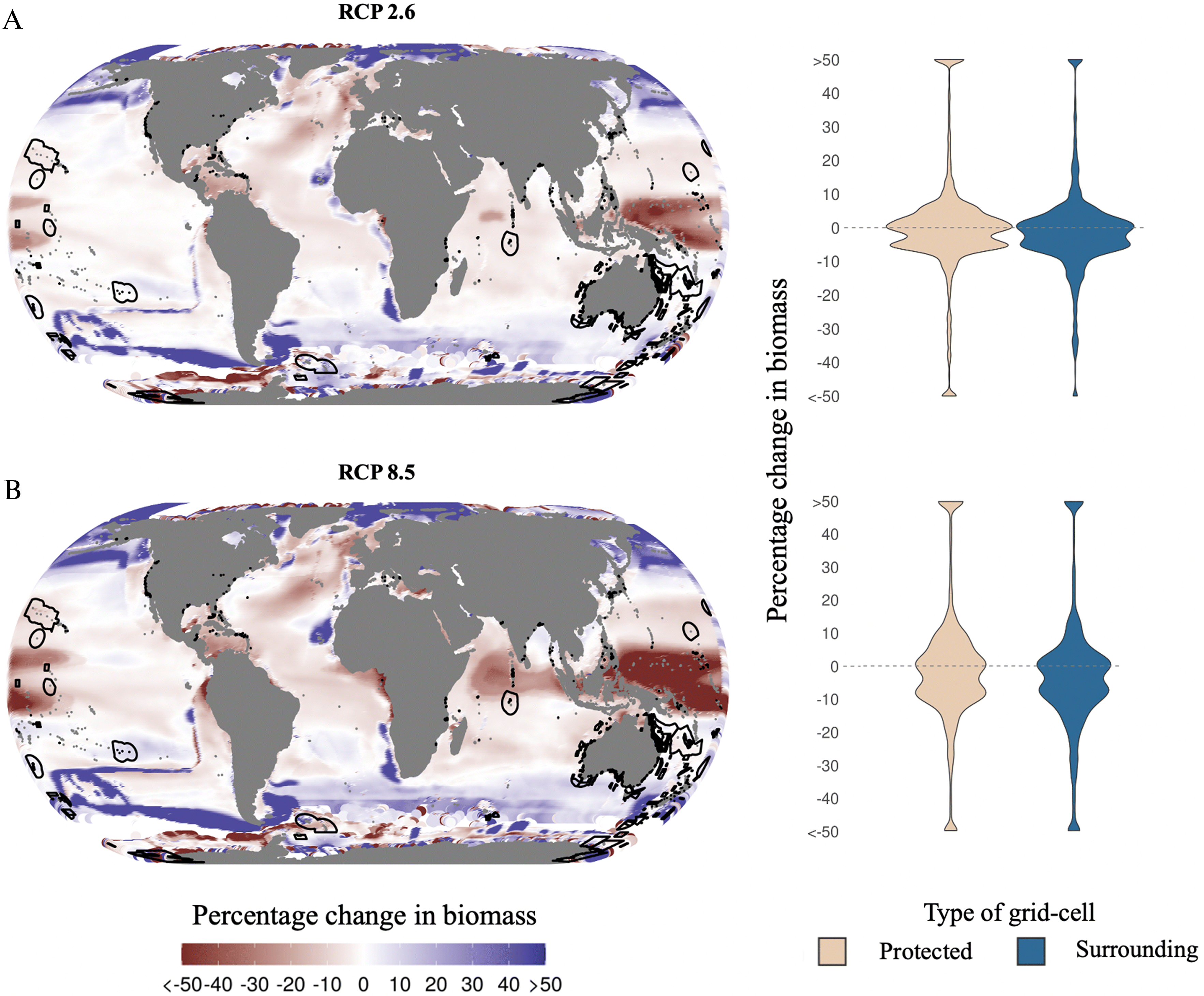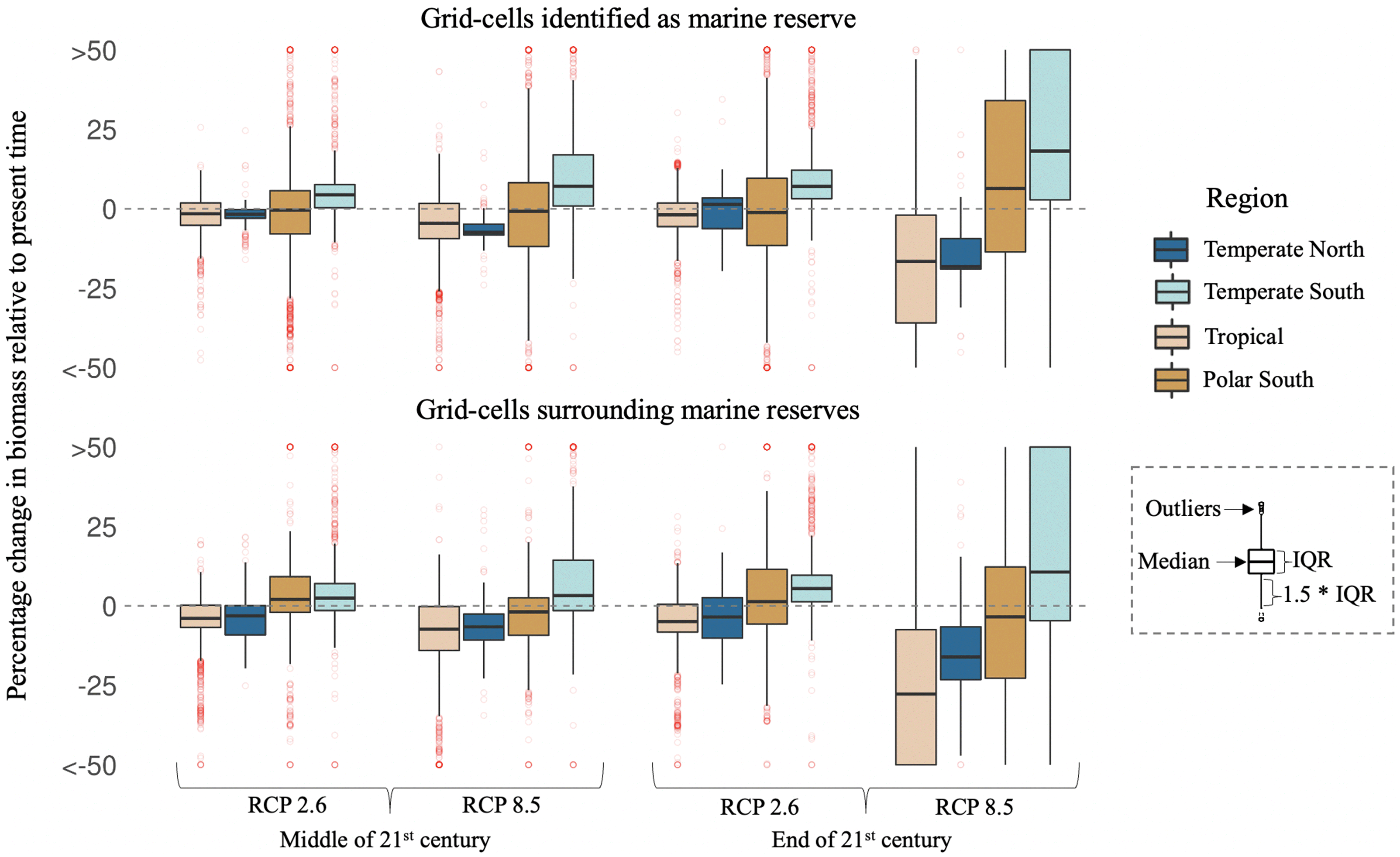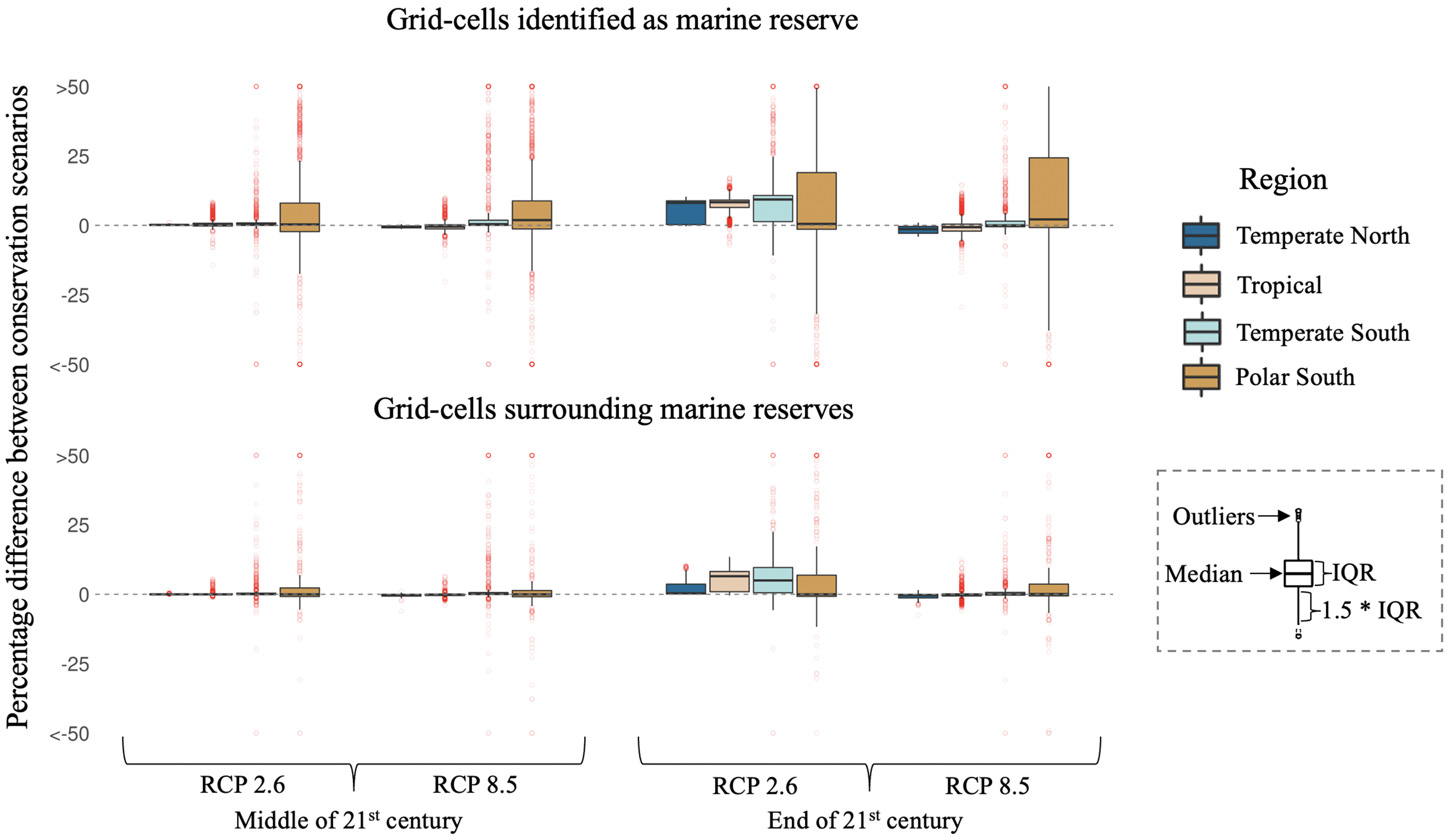Introduction
The United Nations Convention on Biological Diversity (CBD) is discussing protecting 30% of the world’s oceans by 2030 (
CBD 2021). Marine reserves are among the most popular tools for conservation (
Song et al. 2017) and the main tool to reach the proposed target. No-take marine reserves (
Costello and Ballantine 2015) can lead to increases in population biomass, density, resilience, individual size, and species diversity within the reserve’s boundaries (
Micheli et al. 2004; Halpern 2014; Chirico et al. 2017; Friedlander et al. 2017). Such effects can lead to spillover of adult fish biomass in waters up to 2 km away, sometimes increasing fisheries yield (
Halpern et al. 2009). While, in some cases, reserves have proven useful for promoting and protecting biomass (
Halpern et al. 2009), improper implementation has led to little to no impact (
Halpern 2003). Indeed, marine reserve performance both inside and outside of protected areas is not always clear (
Hilborn et al. 2004;
Ovando et al. 2021) and other socioecological variables are needed to maximize the benefits of marine reserves (
Edgar et al. 2014;
Grorud-Colvert et al. 2021). Moreover, as climate change shifts the distribution of marine species worldwide, questions remain regarding the impacts of such shifts to the effectiveness of marine reserves (
Bruno et al. 2018;
IPBES 2019;
Jacquemont et al. 2022).
Climate change is one of the main threats to sustainable global ocean governance. The ocean has absorbed 90% of the excess heat produced by greenhouse gasses and captured about 30% of carbon emissions since the industrial revolution leading to warmer, more acidic, and less oxygenated oceans (
IPCC 2022). This pattern is expected to continue through the 21st century. For example, sea surface temperature increase and dissolved oxygen decrease will have exceeded natural variability in about 40% of global protected areas by the mid-21st century (
Bruno et al. 2018). Marine species have adopted different strategies to cope with these changes, with many shifting their known distribution by about 72 km per decade following the environmental conditions favorable to their development (
Poloczanska et al. 2016). Moreover, modeling exercises suggest that such shifts are projected to continue regardless of the climate change scenario (
Tittensor et al. 2021). The movement of species directly threatens conservation outcomes as most marine reserves are not designed with shifting species ranges in mind (
Fredston-Hermann et al. 2018; Cashion et al. 2020).
The ecological effects of climate change are projected to be more intense at equatorial latitudes (
Gattuso et al. 2015), a region where most marine reserves have been implemented (
McLeod et al. 2009;
Davies et al. 2017;
UNEP-WCMC 2019). Climate change impacts could have a cascading effect on socioecological systems, such as fishing and ecotourism, that depend on marine reserves and their benefits from biological spillover. These impacts could also be exacerbated by other human activities such as coastal runoff (
Crain et al. 2009), illegal fishing (
Dalton et al. 2015;
Dureuil et al. 2018), and water pollution (
Schiff et al. 2011), ultimately threatening the conservation goals of marine reserves. Given the threats of climate change on marine species and the use of reserves as a common tool for achieving international goals, it is essential that we understand the relationship between marine reserves and climate change (
IPBES 2019).
This study intends to contribute to the understanding of the hypothetical benefits of marine reserves in a changing world. Here, we ask (i) how is the biomass of marine reserves and its surrounding waters impacted by climate change? (ii) is that impact similar across different ecological regions? and (iii) would a changing world with marine reserves be better off in terms of fish biomass than a world without the protection of the marine reserves? To answer these questions, we combine a species distribution model with three Earth system models (ESMs) under two climate change and conservation scenarios. Our study is a simulation of a hypothetical world where all reserves are indeed fully no-take, well managed, and effective in promoting biomass. Moreover, we assume that marine reserves do not displace fishing effort to surrounding regions and fisheries are well managed outside protected waters. While such assumptions leads to a more utopian, rather than realistic, view of the current situation of the world’s marine reserves and fisheries, our simulation can help shed light on whether reserves maintain their benefits in terms of fish biomass in a changing world.
Results
To answer our first question (
i) how is the biomass of marine reserves and its surrounding waters impacted by climate change?, we compared the projected biomass of the conservation model in the mid and end of the 21st century relative to the present time (
Fig. 1.4 bottom). As expected, global marine ecosystems will be impacted differently by climate change due to their natural ecosystemic structures and processes. Our results mirror these patterns by presenting an infinitely small average change in global biomass relative to today, yet large regional variations.
By the mid-21st century, marine reserves in our study are projected to have a global average change in biomass relative to today of −1% and 0% under a low and high emission scenario, respectively (
Fig. 2). However, such a small (global) value is masked by a large variation (s.d.) of results ranging from ± 24% to ± 28% in a low and high emission scenario, respectively (
Fig. 2B). Indeed major changes in biomass (i.e., > ± 50% change) are expected in some cases, regardless of the climate change scenario (
Fig. 2). A similar pattern can be seen in surrounding waters where global change averages from 0% (s.d. 17%) under a low emission scenario to −2% (s.d. 25%) under a high emission scenario (
Fig. 2B). Toward the end of the 21st century, changes in biomass will intensify under the high emission scenario while fewer extreme changes are expected under the low emission climate change scenario (
Fig. S4). By then, average changes in biomass within protected waters will range from 3% (s.d. 26%) under a low emission scenario to 0% (s.d. 45%) under a high emission scenario while surrounding waters will change between 0% (s.d. 19%) to −12% (s.d. 46%) biomass under a low and high emission scenario, respectively. Note that variation (s.d.) by the end of the 21st century is larger, suggesting more extreme positive and negative impacts.
We ran a Chi-squared goodness of fit test in the conservation scenario to explore regional differences in the projected direction of change in biomass (e.g., positive or negative change) by the mid and end of the 21st century, relative to today (question
ii). Overall, the direction of biomass change was not equally distributed (
p < 0.05) within protected and surrounding waters of the tropics and temperate regions for both climate change scenarios (see
Table S3 for full statistical analyses).
For the tropics, where most marine reserves are present (total number of grid cells 12,024), we found a significant difference (
p < 0.05) in the distribution of biomass change direction for all combinations of grid cell type, time frame, and climate change scenario. Overall, it is expected that both protected and surrounding waters of the tropics lose biomass regardless of the climate change scenario (
Fig. 3). Similarly, southern (total number of grid cells 4,332) and northern (total number of grid cells 1,036) temperate biomes presented significant (
p < 0.05) differences in the distribution of the biomass change direction for all but one case. The only case where no significant difference is found (χ
2 = 1.130841, df = 1,
p = 0.29) is in northern temperate protected areas at the end of the 21st century under a low emission climate change scenario. While southern protected and surrounding waters tend to increase in biomass, northern waters are projected to decrease in biomass, regardless of the climate change scenario (
Fig. 3). It is worth noting the lower number of marine reserves (and thus, grid cells) in the temperate north relative to other biomes. Finally, results in the southern polar biome are mixed. Here, most protected grid cells do not present a significant difference (
p > 0.05) in the distribution of biomass change direction, except for the end of the 21st century under a high emission climate change scenario (χ
2 = 17.6177606, df = 1,
p = 0.3). However, all surrounding cells show a significant difference in the distribution of biomass change direction (
p > 0.05), regardless of the time frame or climate change scenario. This result could be influenced by the ecological complexity of the biome as well as the characteristics of the few species modeled for the region and their associated fisheries (e.g., krill).
Finally, to evaluate if a world threatened by climate change will be better off with marine reserves in terms of fish biomass than a world without them (question
iii), we compared the projected biomass with a version of the DBEM that did not incorporate marine reserves (
Fig. 1.7). While comparing absolute biomass would be misleading (see the
Methods section), we compare the biomass difference between conservation scenarios for each time frame and assess whether the difference expands or contracts. Under a low emission scenario, the difference in biomass between the conservation scenarios at present time is 30% (i.e., on average, there was 30% more biomass in the conservation scenario due to the presence of marine reserves). By 2050, that difference increased to 31% and by the end of the century to 34% suggesting that marine reserves are positively impacting biomass. However, under RCP 8.5 the difference is 30% for all time frames, suggesting that marine reserves alone cannot ameliorate climate change impacts under a high emission scenario.
We also compared the differences between conservation scenarios in terms of percentage change in biomass relative to today. By the mid-21st century, protected cells from the conservation scenario average between 2% (s.d. 18%) under a low emission scenario and 3% (20%) under a high emission scenario more biomass change than the non-conservation scenario. Toward the end of the 21st century, the difference increases to 9% (s.d. 20%) under low emissions and decreases to 5% (s.d. 25%) under high emissions. While similar, albeit smaller, trends are found for surrounding grid cells, no difference in biomass change between conservation scenarios is found for unprotected grid cells, for all but the end of the 21st century under a low emission climate change scenario (
Table S4). The southern temperate and polar protected and surrounding waters present the largest average gains for the conservation scenario in terms of biomass, especially toward the end of the century (
Fig. 4). In contrast, tropical protected and surrounding waters show no apparent difference in (average) biomass change between conservation scenarios for all but the low emission scenario where they outperform the non-conservation scenario toward the end of the 21st century (
Fig. 4). Although the conservation scenario outperformed the non-conservation scenario on a global aggregate, some grid cells (n = 4295; 2.5% of all grids) had a negative percentage difference between conservation scenarios (
Fig. 4). In all of these cases, there was a higher starting biomass in the conservation scenario, leading to larger differences in percentage change in biomass compared to the non-conservation scenario that had relatively less initial biomass to lose (
Table S5). Yet, in all cases, absolute biomass was still larger under the conservation scenario by both the mid and the end of the 21st century.
Discussion
We sought to understand how the biomass of marine reserves and its surrounding waters will be impacted by climate change globally and across different ecological regions. Our simulations suggest that climate change will have an overall negative impact on fish biomass within marine reserves and their surrounding waters throughout the 21st century. However, the impact varies from large losses in fish biomass in some tropical reserves to fish biomass gains in higher latitudes (
Fig. 2). This pattern is especially pronounced under a high emission scenario (RCP 8.5) suggesting that some reserves (mostly tropical) will not be able to fully protect shifting species under extreme climate change. Yet, while tropical marine reserves may suffer the most under climate change, they could still provide benefits to communities in the future (
McLeod et al. 2009;
Davies et al. 2017). Overall, well-managed marine reserves are expected to continue to provide other benefits under climate change such as refugia area from the effects of fishing leading to older and larger (hence, more resilient) populations, the protection of ecosystem’s resilience and diversity, and carbon sequestration, thus promoting adaptation of socioecological systems to climate change (
Micheli et al. 2012;
Roberts et al. 2017;
Jacquemont et al. 2022).
Climate change impacts to marine reserves will differ across ecological regions. Tropical marine reserves might not fully combat the expected range shifts of marine species toward more suitable habitats. Addressing such deficiency is critical as species richness in the tropics is higher (
Reygondeau 2019), marine reserves are most abundant (
UNEP-WCMC 2019), and climate change is expected to have some of the largest impacts on marine ecosystems in this region (
IPCC 2019). While at localized levels tropical marine reserves could still provide some benefits, especially when marine species follow local temperature gradients away from the poles (
Clarke et al. 2021), emissions mitigation will be required to enhance the protection of tropical biodiversity. As climate change pushes species away from the tropics, temperate marine reserves may be even more important as corridors for protecting biodiversity (
Sullivan-Stack et al. 2022). Thus, the low number of marine reserves in the global northern temperate biome (
UNEP-WCMC 2019) may need to be revised to protect biodiversity in this region. The presence of marine reserves in the polar regions may have positive outcomes for established species and future biomass moving into the region (
Dahood et al. 2020) while counteracting an increase in fishing pressure (
Watters et al. 2020). It is important to keep in mind the high uncertainty of climate change projections, and thus coupled ecological models, especially for polar regions (
Bryndum-Buchholz et al. 2019;
IPCC 2019). Accounting for such uncertainties while creating alternative designs of marine reserves that are climate resilient will help protect biomass from the impacts of climate change globally (
Bryndum-Buchholz et al. 2022). Such designs include dynamic marine reserves that shift their borders following the redistribution of species under climate change (
Maxwell et al. 2020;
Cashion et al. 2020), large reserves (
Davies et al. 2017), and networks of protected areas (
McLeod et al. 2009;
Sala et al. 2021).
We also sought to understand whether a changing world with marine reserves would be better off in terms of fish biomass than a world without the protection of the marine reserves. We found that a world with marine reserves will still outperform a world without them. However, the benefits of marine reserves are reduced under a high emission scenario. Under a high emission scenario, marine reserves will not be able to fully combat the major losses to biomass as a result of extreme climate change. Regardless of whether it is plausible or not to reach the warming level set by the high emission RCP 8.5 scenario (
Burgess et al. 2022;
Pielke et al. 2022), any greenhouse gas mitigation is expected to lead to less extreme changes in biomass, especially after the mid-21st century (
Frölicher et al. 2016). Current global agreements, such as the Paris Agreement and UN Conference of Parties, are ever more important to not only keep global temperature increases below 2 °C but also promote the effectiveness of current marine reserves and achieve global sustainable development targets. Regionally speaking, having marine reserves is increasingly more beneficial in higher latitudes as species move from the tropics to polar regions and decrease in the tropics in an extreme (high emission) scenario (
Cheung et al. 2009b;
Cheung, Reygondeau, et al. 2016). The projected regional differences in biomass changes in protected waters can be attributed to the parallel change of several ocean variables (e.g., temperature, dissolved oxygen) from historical variability (
Bruno et al. 2018). In theory, a world with marine reserves also means that surrounding waters will benefit from more biomass through spillover (
Halpern et al. 2009). Our model supports this theory resulting in less losses in biomass in waters directly surrounding marine reserves in comparison to when no marine reserve is implemented, under future climate change scenarios. However, the spillover effect continues to be a source of contention as recent studies have noted that protected areas provide benefits to biomass within their borders, but that their contributions to local and regional population-wide effects are less evident (
Ovando et al. 2021).
Marine reserves may ultimately support the desired goals of healthier and more diverse ecosystems under climate change; however, socioecological contexts must be considered when designing, maintaining, and implementing them (
Charles and Wilson 2009;
Dalton et al. 2015;
Grorud-Colvert et al. 2021;
Jacquemont et al. 2022). Reserves can be used to conserve core habitat for endangered species and may be used for recreation that supports marine conservation (
Marcos et al. 2021). Reserves can have multiple goals beyond biomass or biodiversity conservation and climate change mitigation (
Dalton et al. 2015), and these differential goals should be considered when designing and examining their effectiveness. Nonetheless, reserves may not always be the best approach (or only) to follow (
Hilborn et al. 2004). For example, the implementation of a marine reserve on previously fished waters will likely displace fishing effort to surrounding regions (rather than eliminating it). This effect will often lead to overfishing in surrounding waters, potentially impacting the efficiency of the reserve and surrounding fisheries (
Gilman et al. 2019;
Cashion et al. 2020;
Hilborn and Sinclair 2021). Thus, the implementation of marine reserves needs to be under a holistic ocean governance framework. Our hypothetical world requires sustainable fishing across the globe and that marine reserves are well enforced to isolate the effects of climate change. While these sound like utopian assumptions, the cost for supporting a network of marine reserves has been estimated to be less than that spent globally on harmful subsidies to industrial fisheries (
Balmford et al. 2004), which also directly threaten ocean sustainability (
Sumaila et al. 2021). Nevertheless, such assumptions mean that our model does not account for illegal fishing, enforcing of rules, nor potential displacement of fishing effort by marine reserves. Protecting ocean waters as a global responsive conservation strategy, especially in light of climate change and mass extinction, is an important contribution to the goals of the CBD which seeks to increase global protection coverage to 30% (
CBD 2021) as well as achieving target 14 – Life Below Water of the Sustainable Development Goals (
United Nations 2018). For marine conservation to thrive, ocean governance needs to be improved globally, while also considering the complexity of local socio-ecological contexts (
Edgar et al. 2014;
Ban et al. 2018;
Sullivan-Stack et al. 2022;
Hilborn and Sinclair 2021). The current conservation agenda should consider not only this but also the impacts of climate change to promote climate resilient marine reserves if we are to maintain and recover biodiversity in the ocean (
IPBES 2019) while not negatively impacting other socioecological systems.





